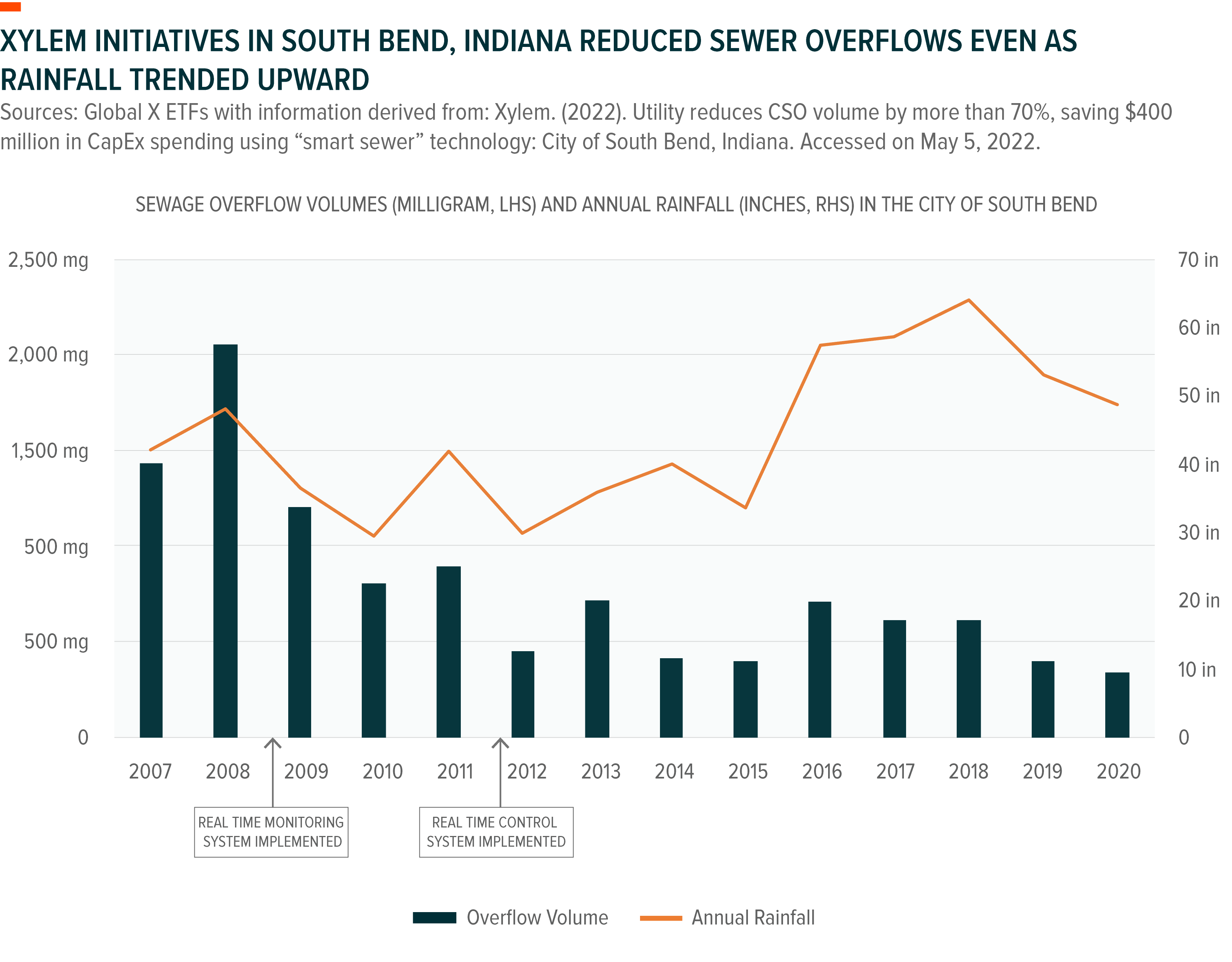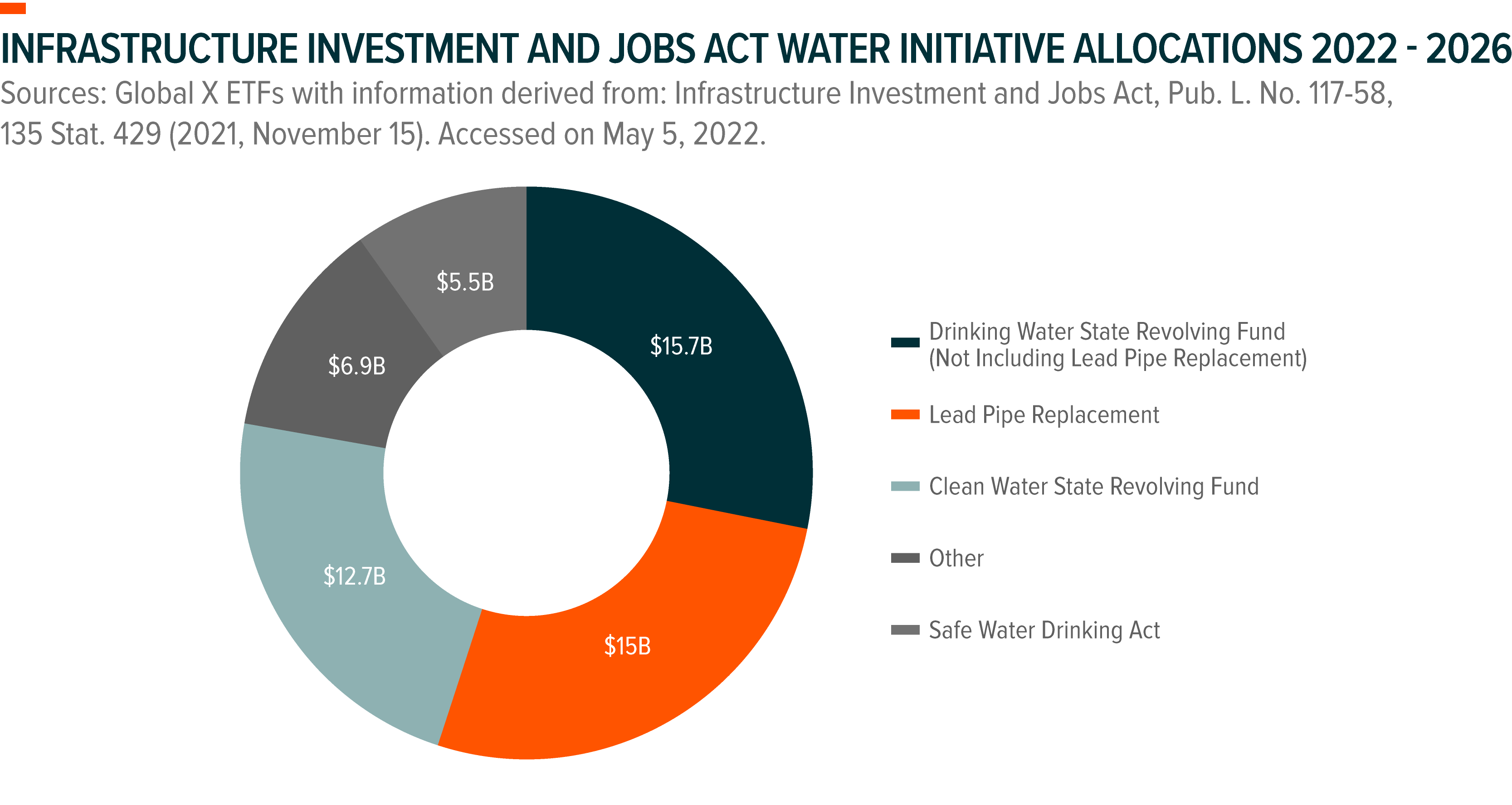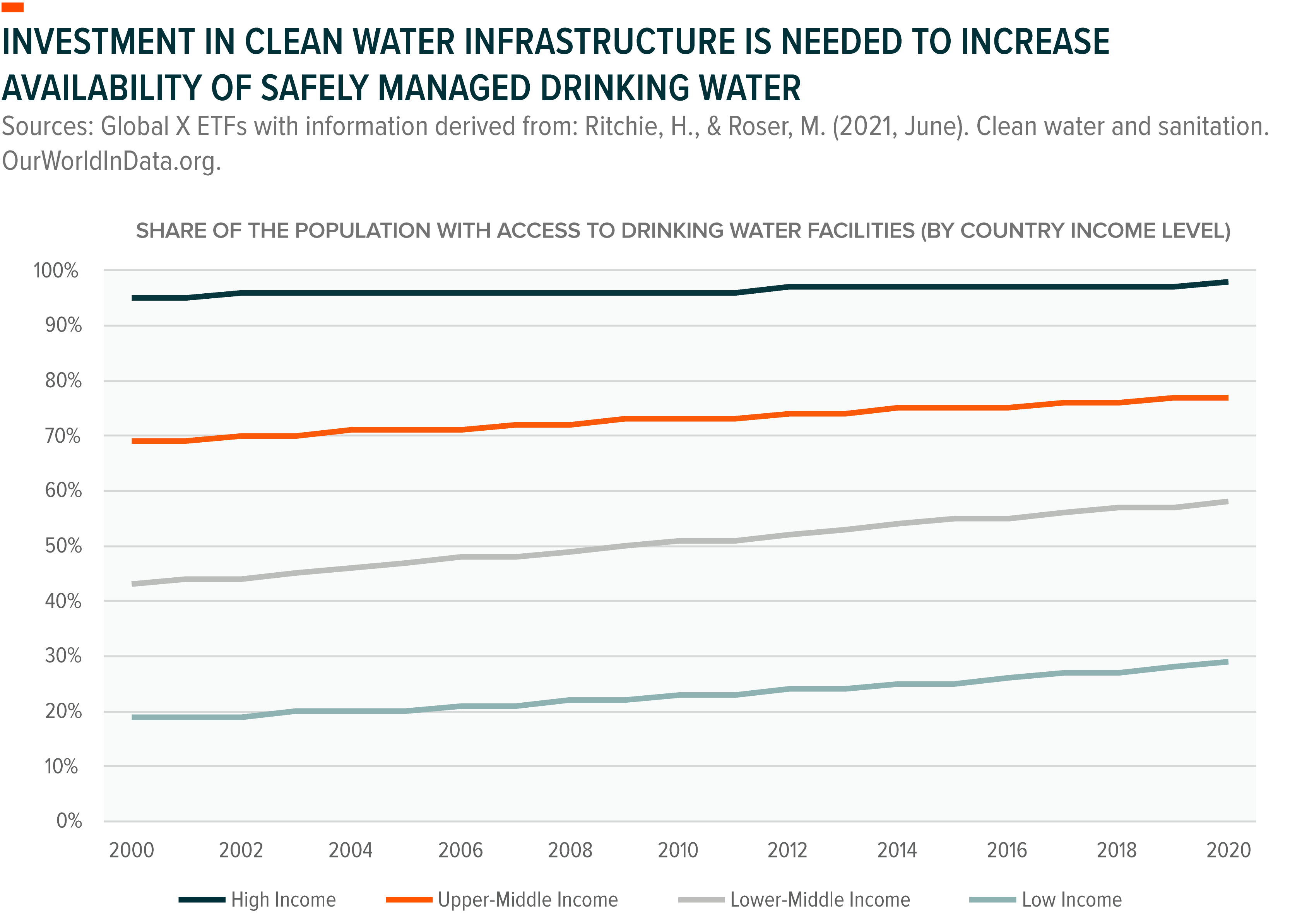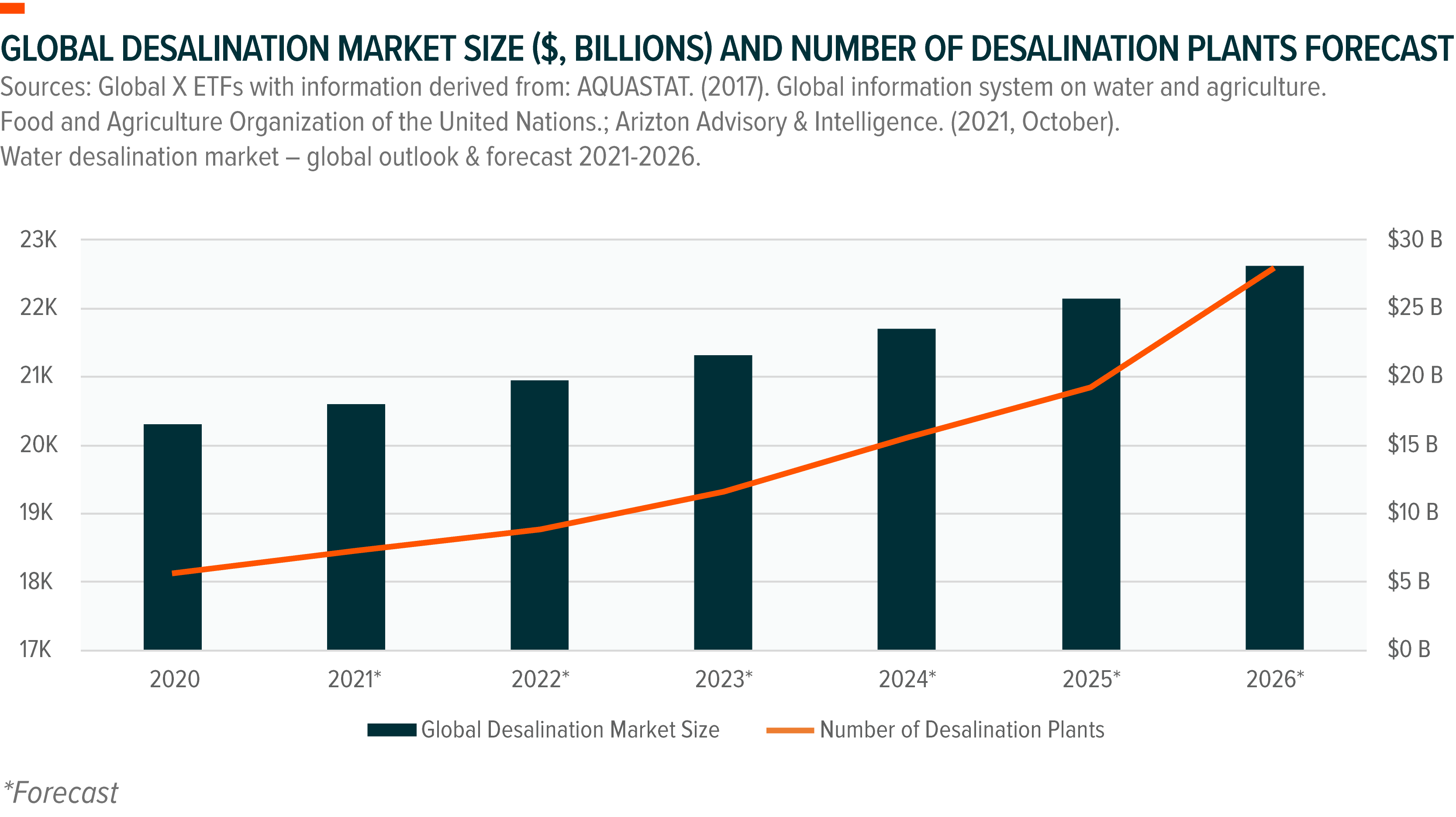Four Companies Sustaining Water Supplies
More than 3.5 billion people currently experience water scarcity, and 10% of the global population lives in countries that the United Nations considers to have high or critical levels of water scarcity.1,2 In addition to representing a grave health concern, limited access to clean water disrupts segments ranging from agricultural production to hydroelectric generation to semiconductor manufacturing. Unfortunately, water shortages are expected to proliferate, with as many as 5 billion people forecasted to experience water scarcity by 2050.3 However, companies are working to improve the water cycle and promote more thoughtful approaches to our precious water resources.
In this piece, we highlight four companies in the Global X Clean Water ETF (AQWA) that could help optimize water use or otherwise mitigate future shortages.
- Xylem: Offers a wide array of optimization solutions for water transportation and treatment
- Mueller Water Products: Manufactures water distribution and measurement products
- Ecolab: Develops technology and services for water treatment and purification
- Energy Recovery: Produces equipment used in the desalination process
Xylem: Using Every Drop of Water
Fundamental vulnerabilities in how clean water and wastewater are transported result in needless water loss. Leaky distribution pipes are difficult to detect quickly and can result in significant volumes of lost water if left unattended. This issue is so prominent in North America that an estimated 20–50% of water is lost in distribution.4 Globally, there is a roughly 30% disparity between the volume of water utilities deliver and the amount of water billed. According to the World Bank, the water lost costs the global economy $14 billion annually.5
Antiquated wastewater management systems can also compromise clean water supplies, particularly those that are not calibrated for climate change. Consequently, system operators often have little ability to prevent disruption when sudden weather events wreak havoc on facilities. Sewage overflows are common after flooding or heavy precipitation events, resulting in contaminated water supplies. Last year, storm overflows in the United Kingdom dumped raw sewage into rivers and seas about 373,000 times.6
To improve water management, Xylem Inc. deploys smart water innovations that use sensors, automation, and data analysis. Its virtual district metering areas (vDMAs) interpret information from flow meters to detect when leaks occur. In Park City, Utah, Xylem’s VDMA services reduced leaks by 10%.7 The vDMA framework merged acoustic, pressure, and flow rate data to identify three times the amount of water loss than was previously known.8
In another case, Xylem leveraged digital monitoring in South Bend, Indiana to reduce sewer overflows by 70%.9 Internet of Things (IoT) analytics informed better decision-making during storms and allowed system operators to pre-emptively clean sewage blockages. Besides water savings, the system reduced E. coli concentrations in a local river by 50%.10
Utilities around the world are embracing smart water technologies to boost efficiency and water savings. Water utility spending on digital technologies could increase at a compound annual growth rate (CAGR) of 9% between 2020 and 2025, compared to a 3% CAGR for all other spending.11 Accordingly, Xylem aims to derive 50% of total revenues from digital products and services by 2025, up from 35% in 2021.12 Further adoption of digital water equipment could act as margin catalyst for Xylem, as digitally augmented gear and accompanying service contracts are often more profitable than other business lines.

Mueller Water Products: Upgrading Decrepit Water Infrastructure
Another avenue to save water could be to upgrade aging infrastructure. In the United States, 6 billion gallons are lost annually due to leaky pipes, amounting to $7.6 billion in losses in 2019.13 Dated infrastructure can also be dangerous because it preserves obsolete design practices. As many as 22 million Americans still drink water delivered by lead pipes, even though lead pipes were outlawed for use in the country’s public water systems in 1986.14,15
The now infamous Flint, Michigan water crisis highlighted such an oversight, as close to 100,000 residents were exposed to lead-contaminated drinking water.16 Severe outcomes ranging from hair loss to birth complications in Flint demonstrate the importance of protecting populations from the design flaws of the past.17,18 To date, the city has replaced more than 90% of relevant lead pipes and could complete this process by September 2022.19,20
The recently passed Infrastructure Investment and Jobs Act (IIJA) directs $55 billion over five years toward various water initiatives in the United States and addresses outdated water infrastructure.21 One of the largest water-related line items in the bill is $15 billion to remove and replace lead pipes, which is enough to eliminate an estimated 25% of the lead pipes in the United States.22
We expect IIJA investments to potentially boost demand for water distribution and control equipment. As local governments replace lead pipeline systems, they will need more than just new pipes. Mueller Water Products is a company that specializes in flow control equipment in North American markets, with over 90% of revenues derived from the United States.23 Relevant products include iron gates, service brass products, pipe repair components, and specialty valves to control water pressure in pipelines. The company is also establishing a new brass foundry designed to forge components made from lead-free brass alloys. This foundry, which is set to begin operations in 2023, could help the company distinguish itself as a manufacturer of safely sourced water equipment.24 This focus on U.S. markets and key offerings may position the Mueller Water Products to support some of the water initiatives set forth by the IIJA.

Ecolab: Boosting Global Water Hygiene
Further development of water sanitation systems could facilitate the safe reuse of water, effectively boosting supplies. At least 2 billion people lack access to safely managed drinking water, and only about half of the world’s population use safely managed sanitation services.25,26 Current sanitation systems offer even less coverage than these metrics might suggest. Globally, 80% of wastewater flows back into the environment without being treated or reused, putting billions at risk of diseases such as cholera, dysentery, typhoid, and polio.27 Besides pathogens, wastewater often contains contaminants such as phosphorous, nitrogen, and industrial metals.
Sanitation coverage has improved in recent decades, with 74% of the world’s population having access to safely managed drinking water as of 2020, compared to 62% in 2000.28 Still, sanitation improvement remains a slow and uneven process. In 2020, only 29% of people living in countries the World Health Organization (WHO) classified as low-income had access to clean drinking water facilities.29
Water purification companies with broad global footprints, such as Ecolab, could prove instrumental in building out wastewater treatment efforts on the industrial side. Ecolab maintains a global presence, providing water treatment equipment, chemicals, and consulting services in more than 170 countries.30 The company’s offerings include chemicals and coagulants, primary wastewater treatment, osmosis membranes, dewatering chemicals, household filters. See our piece, Introducing the Global X Clean Water ETF (AQWA), for an overview of the wastewater treatment process. The company also caters its sanitation expertise toward industries such as food service, hospitality, healthcare, chemical processing, minerals, and power generation.
A diverse business model has allowed Ecolab to accommodate a wide array of needs within the clean water space. In addition to organic growth and continued acquisition activity, the company could find opportunity serving the expanded needs of pre-existing customers. Wastewater treatment is a complex process that often can be improved upon at multiple points. Ecolab’s integration allows the company to address multiple needs from the same customer, which can lead to repeat revenue streams. Growing corporate emphasis on sustainability could also act as a tailwind. Ecolab focuses on boosting the efficiency of sanitation processes, an attractive prospect for companies who are likely to pursue incentives for reducing their energy and water footprints. Thanks to efforts to diversify and expand its offerings, Ecolab is estimated to serve a potential market of $150 billion worldwide, up from $100 billion in 2011.31,32

Energy Recovery: Sourcing Drinking Water from the Ocean
Another strategy to improve water supplies is to simply source more of it. Desalination is a process that removes salt and other minerals from seawater or brackish groundwater and converts it to fresh water. Although the desalination industry remains in its early stages, it is a technology deployed at scale that already provides clean water to more than 300 million people globally.33 Further adoption of desalination could tap into the 97.2% of the world’s water that is contained in the ocean and greatly expand the amount of freshwater available.34 Besides bolstering water supplies, desalination could protect against some of the impacts of climate change. Rising ocean levels are expected to permeate into aquifers and coastal freshwater sources, in some cases rendering these resources undrinkable.35
Energy Recovery provides equipment meant to bolster efficiencies of industrial fluid-flow markets worldwide, with a primary focus on reverse osmosis seawater desalination. Energy Recovery’s product suite includes pumping systems, turbochargers, and pressure exchangers for desalination plants. Such products specifically seek to mitigate one of the biggest issues with desalination: high energy intensity. Energy use accounts for 50-60% of total desalination costs, thus power conservation could decrease costs and encourage adoption of the technology.36 In 2020, the company’s line of pressure exchange devices saved desalination customers $2.6 billion in energy costs and avoided 12.5 million metric tons of carbon emissions.37 On a facility basis, pressure exchangers can reduce energy use by 60%.38

Conclusion
The increasing impact of water scarcity and the threat of further shortages cannot be ignored. Water is essential to life and a basic human right, never mind its role as an economic cornerstone. Fortunately, the private sector continues to innovate in areas such as smart water optimization, infrastructure replacement, advanced water purification, and water sourcing. In our view, companies in these spaces, like Xylem, Mueller, Ecolab, and Energy Recovery, could potentially benefit as the world increases its investments in strategies designed to avoid the worst water shortage outcomes.
Related ETFs
AQWA: The Global X Clean Water ETF seeks to invest in companies advancing the provision of clean water through industrial water treatment, storage and distribution infrastructure, as well as purification and efficiency strategies, among other activities.
Click the fund name above to view the fund’s current holdings. Holdings subject to change. Current and future holdings subject to risk.


